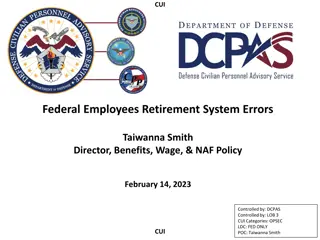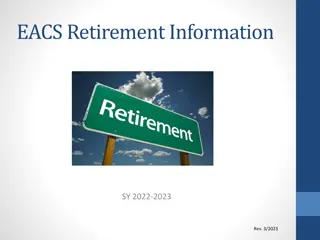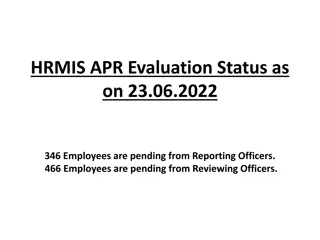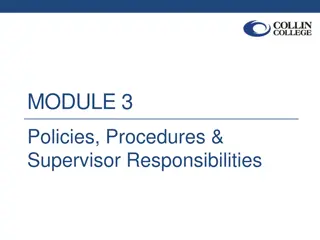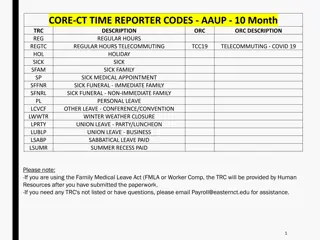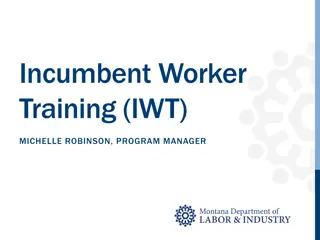Comprehensive Telecommuting Training for Employees
Introduction to telecommuting training for employees, covering topics such as defining telecommuting, benefits to employees and employers, criteria for selecting telecommuting employees, application process, and tips for effective telecommuting. The content emphasizes the advantages of telecommuting in terms of productivity, job satisfaction, reduced stress, health benefits, cost savings, flexibility, and increased productivity for both employees and employers.
Download Presentation

Please find below an Image/Link to download the presentation.
The content on the website is provided AS IS for your information and personal use only. It may not be sold, licensed, or shared on other websites without obtaining consent from the author. Download presentation by click this link. If you encounter any issues during the download, it is possible that the publisher has removed the file from their server.
E N D
Presentation Transcript
Telecommuting Training for Employees
Telecommuting Training for Employees WELCOME! 2
Introduction Telecommuting is becoming a popular alternative work arrangement as employers look for ways to respond to soaring operating costs, natural disasters and other business continuity issues. Other companies regard telecommuting as a long-term way to proactively balance their business operating needs with employee work-life needs. 3
Agenda How our policy defines telecommuting. Benefits of telecommuting to the employee. Benefits of telecommuting to the employer. Criteria for selecting telecommuting employees. Telecommuting application process. Tips on being an effective telecommuter. 4
How Our Policy Defines Telecommuting [Company Name] defines telecommuting as [fill in your own company definition and description of the program. The description should include information about working from either an office in the employee s home or a telework center that is different from the company headquarters or other company facility]. We may use the word telework to describe the telecommuting work arrangement during our discussion today and in the company policy. 5
Benefits of Telecommuting to the Employee Research indicates that employees who telecommute benefit by having: Greater productivity. Increased job satisfaction. Less stress and better health. Lower commuting costs. More flexibility to balance and manage work and home responsibilities. 7
Benefits of Telecommuting to the Employer Research indicates that companies that allow for telecommuting benefit by having: Increased employee productivity. Reduced absenteeism. Increased job satisfaction, leading to increased employee retention and lower recruitment costs. Reduced office space needs and corresponding expenses. 8
Criteria for Telecommuting According to our policy, the selection criteria for telecommuting employees include employees who: Have demonstrated a thorough and productive understanding of their job, which, for some positions, can take up to six months of continuous employment with our company. Have demonstrated a consistent and acceptable level of productivity and quality by receiving a meets or exceeds performance evaluation within three to six months of their telecommuting request. 10
Criteria for Telecommuting (cont.) According to our policy, the selection criteria for telecommuting also includes: Demonstrated ability to work independently with minimal levels of supervision. Job duties that are not location-specific (e.g., receptionists cannot be telecommuters). A dedicated workspace free from distractions. o Working parents or those who have caretaking responsibilities and will be working from a home office must have viable childcare or caretaking arrangements. Telecommuting should not be considered a substitute for these arrangements. 11
Criteria for Telecommuting (cont.) If there are numerous telecommuting requests within a department, seniority may be used as a determining factor. Telecommuting may also be used in response to modified work, light- duty assignments or requests for reasonable religious and/or disability accommodations. 12
Telecommuting Application Process All requests to telecommute must be submitted in writing to your immediate supervisor. Include an explanation as to why you will be an effective telecommuter and answer the following questions: How will you continue to access the resources you need to do your job (e.g., files, computers, etc.)? Who else needs to know when and where you are working to do their jobs? How will you communicate your availability with coworkers and customers/clients on a regular basis? How will you communicate your work progress on an ongoing basis to your manager and other stakeholders? What work processes need to be revised to allow you and others to incorporate telework effectively? 14
Telecommuting Application Process Management will review telecommuting applications with the employee s immediate supervisor and HR. A response will be provided to the employee within two weeks of receipt of the telecommuting application. Immediate supervisors will notify employees of the decision. 15
Tips on Being an Effective Telecommuter Create a productive workspace free from household distractions if you are working from home. Verify that you know how to operate all company-provided equipment and that you have alternate plans should you encounter problems. (The company provides telecommuters with computer equipment and will reimburse reasonable Internet access expenses.) 17
Tips on Being an Effective Telecommuter Use company-provided communication tools to keep in contact with your manager and colleagues on a regular basis to manage feelings of isolation. Schedule in advance with your manager the day(s) you will be in the office to verify that space is available. 18
Summary Telecommuting is a popular alternative work arrangement. It has benefits for both employers and employees. Telecommuting is not a suitable option for all jobs or all employees. Our policy includes specific criteria for telecommuting employees. Tips for being an effective telecommuter include creating a productive workspace free from distractions, knowing how to operate the telecommuting equipment, and fully using communication tools to keep in contact with your manager and colleagues. 19
Training Evaluation Please complete the training evaluation sheet included in the handouts. Thank you for your interest and attention! 21



